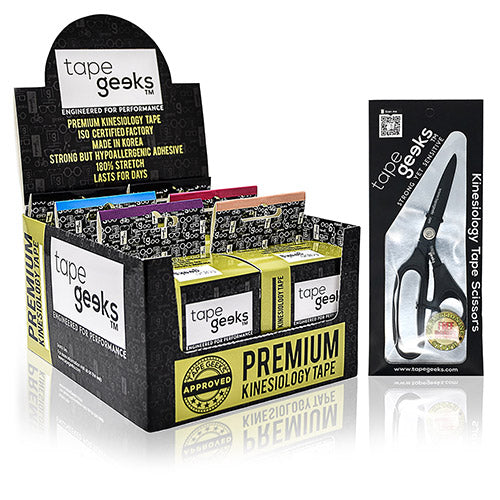
Osteoarthritis of the knee not only affects one’s ability to stay active, but it can also have a significant impact on the ability to perform regular daily tasks, which in turn can have a negative effect on mental health.

Shop our kinesiology tape now
Shop Now
An interesting thing about our current aging population, the Baby Boomers, is that, unlike their parents who were not as focused on sports and leisure pursuits, the Boomers are not willing to slow down nor are they quick to use drugs as part of their aging prevention protocol. This may be a contributing factor to the popularity of kinesiology tape as a way to help control pain and the expanding body of research knowledge on this treatment modality.
Here are the highlights from a recent study that looked at the benefits of using kinesiology tape for knee arthritis.
The Study
A group of 30 older adults (67-79) with uncomplicated knee arthritis were split into 2 groups:
- The Standard Therapy Group received warm packs and interference wave therapy.
- The Kinesiology Tape Group received the same treatment as the other group plus the application of kinesiology tape (re-applied at each treatment session).
The taping protocols were slightly different between participants depending upon whether they experienced more discomfort of their knee while flexing or while extending the joint.

Shop our bundles now
Shop Now
If the patient felt more pain flexing (bending) the knee, the tape was applied to the hamstring and tibialis anterior muscles.
If the patient felt pain while extending (straightening) the knee, the tape was applied to the quadriceps femoris and the gastrocnemius muscles.
Each of the 30 participants was treated at the same facility 3X/week for 4 weeks.
Both groups of patients were asked to assess their pain, their ability to do daily tasks and a therapist measured the knee range of motion both before and after the 4-week study.

The Results
All three areas (pain, activities of daily living, and knee range of motion) improved significantly more over the 4-week study in the group that used the kinesiology tape as compared to those who did not.
Discussion
This study is amongst others (2,3,4)that suggest kinesiology tape can be an effective treatment to reduce discomfort and improve function for those with knee arthritis. A number of other studies (4,5) also suggest that other causes of knee pain such as patellar tracking dysfunction can be effectively and safely treated with kinesiology tape.
Learn more about knee pain over here!

Shop our collection now
Shop NowSubscribe to the TapeGeeks Newsletter for new videos, discounts and more!Join The Geeks Club
1. Kwansub L. Chae-Woo Y. Sangyong L. The effects of kinesiology taping therapy on degenerative knee arthritis patients’ pain, function, and joint range of motion. J Phys Ther Sci. 2016 Jan; 28(1): 63–66.
2. Park YS, Kim HJ. Effects of a taping method on pain and ROM of the knee joint in the elderly. Taehan Kanho Hakhoe Chi, 2005, 35: 372–381
3. Cushnaghan J, McCarthy C, Dieppe P. Taping the patella medially: a new treatment for osteoarthritis of the knee joint? B
MJ, 1994, 308: 753–755
4. Lee CR, Lee DY, Jeong HS, et al. : The effects of kinesio taping on VMO and VL EMG activities during stair ascent and descent by persons with patellofemoral pain: a preliminary study. J Phys Ther Sci, 2012, 24: 153–156.
5. Irrgang JJ, Snyder-Mackler L, Wainner RS, et al. : Development of a patient-reported measure of function of the knee. J Bone Joint Surg Am, 1998, 80: 1132–1145









